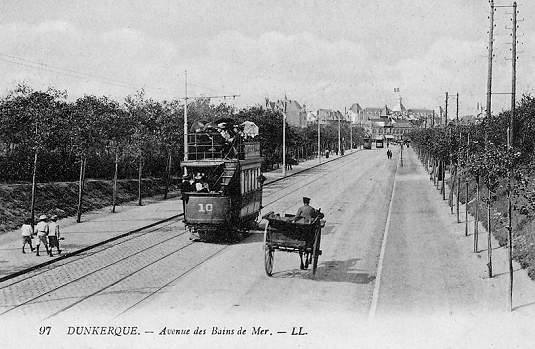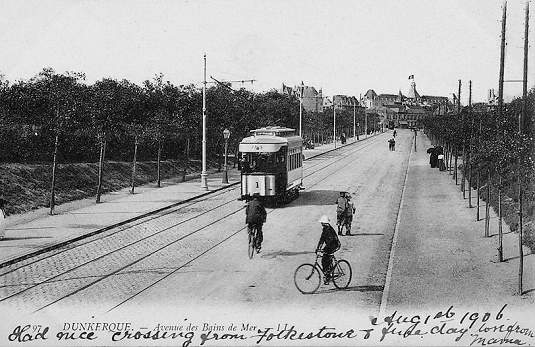



Our two examples here once again show the quirks of cards from French publisher, Lévy Fils et Cie, of 44 Rue Letellier, Paris. Both are card 97 with the title 'Dunkerque, Avenue des Bains de Mer' and the same view, but the tram in each is different. The top card has accumulator tram 10, the one below has conventional overhead electric car 1. The photos were taken on the same occasion in 1903, the lower one being the earliest by about 5 minutes judging by the people shown. It is at the period of the changeover from accumulator to overhead electric traction. Car 1 can just be seen in the background to the view of car 10. Car 10 is clearly in service, but it is possible that car 1 is just on trial.
The tramways in Dunkerque began life in 1880 using horse traction (see postcard). In 1899 the horse trams were replaced by fourteen accumulator cars, which like the previous horse trams were to an English double-deck design with back to back knifeboard seating on the top deck, and with staircases that turned to the left and were on the right side of the cars with the entrances on the left. At this time ownership of the tramway passed to a new company, Société des Tramways de Dunkerque et Extensions. Former horse cars were sometimes used as trailers. The accumulator cars were reported as not being very reliable, with instances of a number being stranded due to expired batteries. During 1903 the tramway was electrified using overhead current collection via trolley poles and the accumulator cars were withdrawn.
The new overhead electric tramway soon began extensions and some of the single track sections were doubled. The first additions in 1903 were the lines from Malo-les-Bains on a further three kilometres to Malo Terminus, and the lower town service from Place de la République to Fort-Loius. The latter was extended in 1907 to Coudekerque-Branch. In 1906 the electrified horse line from Dunkerque to Rosendael was extended to Bassins. Finally, in 1912 the 600mm gauge Saint-Pol horse tramway was taken over, converted to standard gauge and electrified. The system was worked as five routes as follows:- Dunkerque Railway Station to Malo-les-Bains and Rosendael (Victor Hugo); Saint-Pol to Dunkerque Railway Station and Malo-les Bains; Bassins to Rosendael (Railway Station); Coudekerque-Branche to Malo-les-Bains (Turenne); and Malo-les-Bains (Casino) to Malo Terminus. The tram depot was at Malo-les-Bains.
The rolling stock for the electric tramway originally consisted of 25 single-deck two axle motor cars. A number of matching trailer cars were supplemented by the accumulator cars cut down to single-deck and converted to trailers, giving a total of 21 trailers. In 1912 nine similar but vestibuled motor cars were added to the fleet. Later small centre entrance trailers replaced the earlier large trailers, reducing the total of trailers down to 13. The car livery was pale yellow, lined in brown, with brown roofs, underframes, trucksides and lifeguards.
Once it had reached its maximum extent, 16 kilometres of route, little changed on the tramway until severe damage was inflicted by the bombing of the town in 1940 during the Second World War, at the time of the evacuation of the British Expeditionary Force. Most of the tramway was destroyed and only the main route from Dunkerque to Malo-les-Bains was re-instated afterwards. This line was not to last long during the post war reconstruction of the town, and the tramway was replaced by a motor bus service on 3rd November 1952.
![]() Go to Postcard Of The Month Index
Go to Postcard Of The Month Index